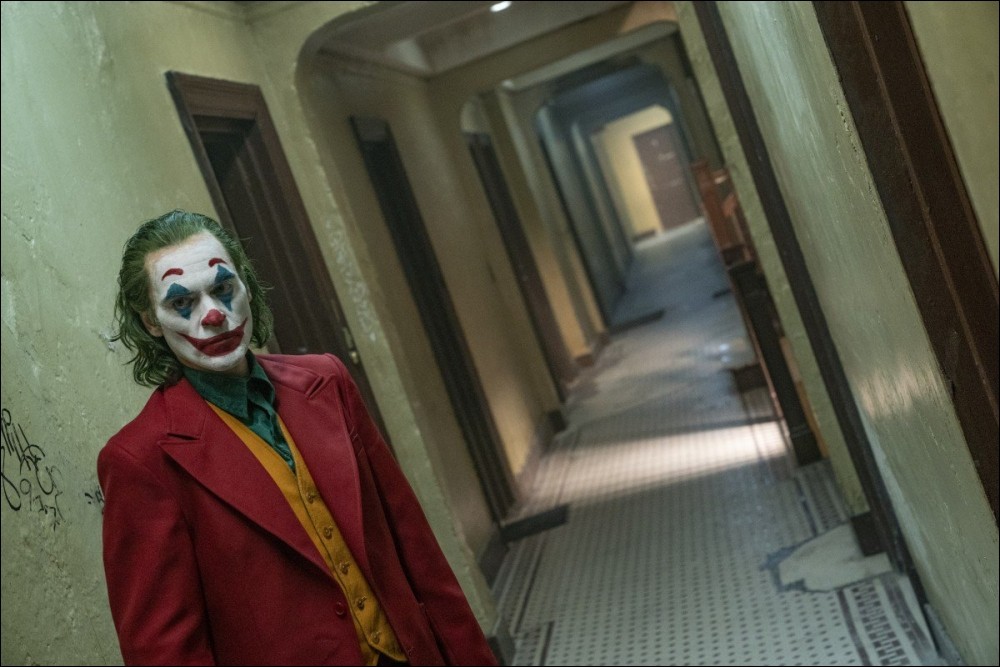JOKER: a welcome howl of rage at injustice

By Harvey Duke
In Joker, Joaquin Phoenix as ‘Arthur’ has the face, and especially the eyes, of a man trapped in hell. He clearly tries hard to be a good citizen: making a precarious living as a clown, looking after his sick mum, being kind to people. Over and over again his gaze and our hopes for him go beyond the suffering he sees and feels. He watches a corny, fake comedian as if he it is great art. He hopes as we all do for a brighter future. Yet, as the horrors of his world pile up on him, we know it isn’t going to end well for him.
When Arthur performs a solitary dance after all the horrors of abuse, poverty, and injustice have twisted his behaviour monstrously, it as if – he is still reaching out for some beautiful, impossible escape. It is an astonishing moment in an unusually sensitive film about the brutality of capitalism in the USA.
This movie has come in for a lot of criticism in the liberal press. Articles have slammed it as glorifying violence, and one Guardian article by two psychiatrists (which shows no evidence of them watching the film) accusing it of stereotyping mental health problems and links to violence. One memorably inaccurate attack howls: ‘Whether intentionally or not, Arthur comes across as a hysterically laughing supervillain, stereotypically “mad” to the untrained eye; a murderous clown laughing alone on a bus.’ (Guardian, 21st Oct, 2019.)
I went to see the film and the bus scene which sticks with me, and I suspect always will, was the key scene in the film where Arthur tries to entertain a child on a bus. The child’s mother growls at him to stop bothering her child. Arthur laughs hysterically: the viewer knows it is caused by his condition. The only sense that he is ‘alone’ in that scene, is in his pain – when he hands a card to the woman which explains that he has a neurological condition which can cause him to laugh. The woman glares at him and turns away. (Much the same reaction has come from liberal reviewers. Something has made them uncomfortable enough to feel the need to misunderstand everything about the film.)
This is not a film which stereotypes people with mental health issues. To claim it does is like claiming that Robert de Niro’s superb portrayal of an establishment comedian stereotypes all comedians. There’s a technical name for such misrepresentation in reviews, but I don’t like to swear. Instead, it’s more useful to ask: would someone be more or less likely to be interested in the societal and psychological causes of mental health problems after watching the film? I suggest that they would be more likely.
I watched the film with my wife Isobel; and we discussed the film afterwards. We both work in caring professions where we encounter people with a huge range of mental health difficulties. We have seen the terrible effects, the spirals of self-destruction, when essential services are taken away from people. Neither of us felt that the film was claiming that everyone with a mental health problem would become uncontrollably violent. The violence (mostly done to Arthur) was simply one part of a story used powerfully to reveal the depths of torture that society subjects the most vulnerable people to. And then it leaves them to suffer.
The film is so powerful because it reverses the average Hollywood glibness and even makes Batman’s mythical father a particularly nasty baddie!
George Orwell once wrote about being in a London pub when the radio news was on and one upper-class presenter’s voice babbled, ignored by everyone, until the commentator imitated for a short time a working-class cockney accent. People suddenly looked up and took notice, as if their world had suddenly been recognised as important. That’s what this movie does in a much bigger way. It is American streets with American poverty which are shown. Yet, it’s not that much different from the horrors of poverty here. Foodbanks, zero hours contracts, bosses who think everyone is such a clown that we’ll blame Brexit for everything, and maybe we will all forget that the vicious cuts were all happening before Brexit. And that the richer were getting richer and will continue to do so after the Brexit debacle explodes, implodes, or is delayed yet again.
When Arthur, after beatings and losing his job and finding out he was abused as a child, finally cracks and lashes out violently, it is not pretty, there’s no excuses offered in the film, it’s one reaction to too much pain thrown not just at him – but against anyone whose hopes and dreams have been mercilessly crushed.
It is the violence of a type of society which has become rotten to the core. And then, alongside a damaged individual lashing out, there’s the depiction of a mass uprising against the rich in America, by the poorest layers. Those scenes must terrify liberals and right-wingers alike in London and in Washington, in Trump’s White House, in Tory clubs in Chelsea, and perhaps -in the wine bars frequented by anti-Corbyn Guardian commentators. Maybe, it’s that suggestion of revolution that scares them so much.
The film is worth seeing. It doesn’t call for socialism, but we can, and we can argue that the kind of semi-coherent mass rage so powerfully depicted in the film can be channeled into a powerful mass movement for socialist change.



